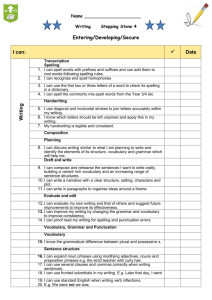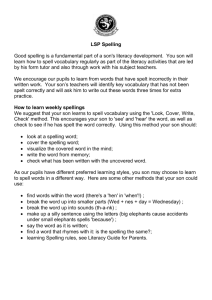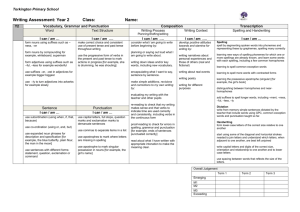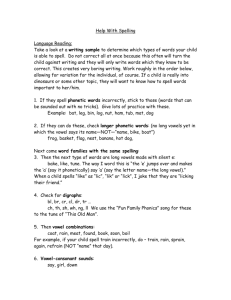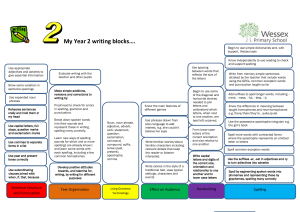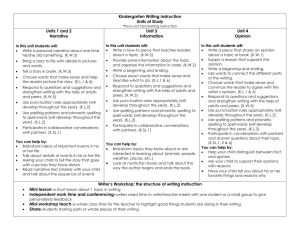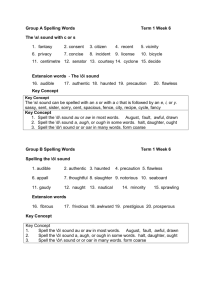Swain House Primary School Writing Assessment Grid Band 5
advertisement
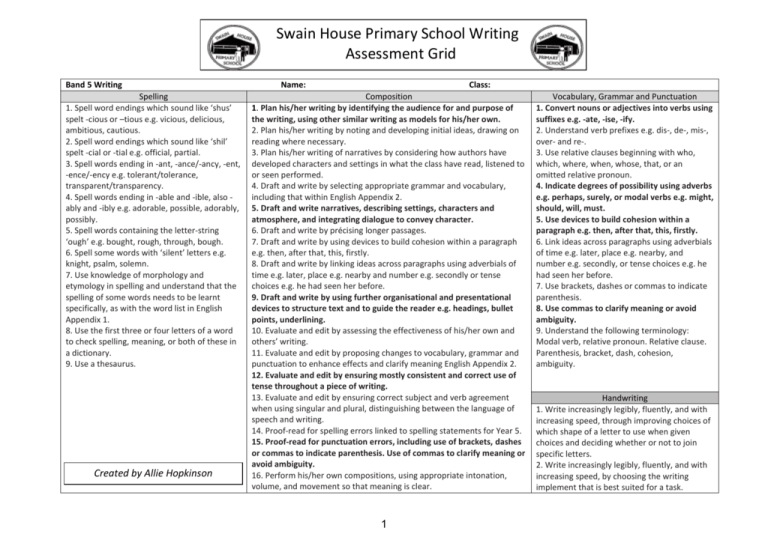
Swain House Primary School Writing Assessment Grid Band 5 Writing Spelling 1. Spell word endings which sound like ‘shus’ spelt -cious or –tious e.g. vicious, delicious, ambitious, cautious. 2. Spell word endings which sound like ‘shil’ spelt -cial or -tial e.g. official, partial. 3. Spell words ending in -ant, -ance/-ancy, -ent, -ence/-ency e.g. tolerant/tolerance, transparent/transparency. 4. Spell words ending in -able and -ible, also ably and -ibly e.g. adorable, possible, adorably, possibly. 5. Spell words containing the letter-string ‘ough’ e.g. bought, rough, through, bough. 6. Spell some words with ‘silent’ letters e.g. knight, psalm, solemn. 7. Use knowledge of morphology and etymology in spelling and understand that the spelling of some words needs to be learnt specifically, as with the word list in English Appendix 1. 8. Use the first three or four letters of a word to check spelling, meaning, or both of these in a dictionary. 9. Use a thesaurus. Created by Allie Hopkinson Name: Class: Composition 1. Plan his/her writing by identifying the audience for and purpose of the writing, using other similar writing as models for his/her own. 2. Plan his/her writing by noting and developing initial ideas, drawing on reading where necessary. 3. Plan his/her writing of narratives by considering how authors have developed characters and settings in what the class have read, listened to or seen performed. 4. Draft and write by selecting appropriate grammar and vocabulary, including that within English Appendix 2. 5. Draft and write narratives, describing settings, characters and atmosphere, and integrating dialogue to convey character. 6. Draft and write by précising longer passages. 7. Draft and write by using devices to build cohesion within a paragraph e.g. then, after that, this, firstly. 8. Draft and write by linking ideas across paragraphs using adverbials of time e.g. later, place e.g. nearby and number e.g. secondly or tense choices e.g. he had seen her before. 9. Draft and write by using further organisational and presentational devices to structure text and to guide the reader e.g. headings, bullet points, underlining. 10. Evaluate and edit by assessing the effectiveness of his/her own and others’ writing. 11. Evaluate and edit by proposing changes to vocabulary, grammar and punctuation to enhance effects and clarify meaning English Appendix 2. 12. Evaluate and edit by ensuring mostly consistent and correct use of tense throughout a piece of writing. 13. Evaluate and edit by ensuring correct subject and verb agreement when using singular and plural, distinguishing between the language of speech and writing. 14. Proof-read for spelling errors linked to spelling statements for Year 5. 15. Proof-read for punctuation errors, including use of brackets, dashes or commas to indicate parenthesis. Use of commas to clarify meaning or avoid ambiguity. 16. Perform his/her own compositions, using appropriate intonation, volume, and movement so that meaning is clear. 1 Vocabulary, Grammar and Punctuation 1. Convert nouns or adjectives into verbs using suffixes e.g. -ate, -ise, -ify. 2. Understand verb prefixes e.g. dis-, de-, mis-, over- and re-. 3. Use relative clauses beginning with who, which, where, when, whose, that, or an omitted relative pronoun. 4. Indicate degrees of possibility using adverbs e.g. perhaps, surely, or modal verbs e.g. might, should, will, must. 5. Use devices to build cohesion within a paragraph e.g. then, after that, this, firstly. 6. Link ideas across paragraphs using adverbials of time e.g. later, place e.g. nearby, and number e.g. secondly, or tense choices e.g. he had seen her before. 7. Use brackets, dashes or commas to indicate parenthesis. 8. Use commas to clarify meaning or avoid ambiguity. 9. Understand the following terminology: Modal verb, relative pronoun. Relative clause. Parenthesis, bracket, dash, cohesion, ambiguity. Handwriting 1. Write increasingly legibly, fluently, and with increasing speed, through improving choices of which shape of a letter to use when given choices and deciding whether or not to join specific letters. 2. Write increasingly legibly, fluently, and with increasing speed, by choosing the writing implement that is best suited for a task. Swain House Primary School Writing Targets Spelling 1. I can spell word endings which sound like ‘shus’ spelt –cious or -tious e.g. vicious, delicious, ambitious, cautious. 2. I can spell word endings which sound like ‘shil’ spelt -cial or -tial e.g. official, partial. 3.I can spell words ending in -ant, ance/-ancy, -ent, -ence/ ency e.g. tolerant/tolerance, transparent/transparency. 4. I can spell words ending in -able and ible, also -ably and -ibly e.g. adorable, possible, adorably, possibly. 5. I can spell words containing the letter-string ‘ough’ e.g. bought, rough, through, bough. 6. I can spell some words with ‘silent’ letters e.g. knight, psalm, solemn. 7. I can use knowledge of root words, prefixes and suffixes in spelling and understand that the spelling of some words needs to be learnt specifically. 8. I can use the first three or four letters of a word to check spelling, meaning, or both of these in a dictionary. 9. I can use a thesaurus. Created by Allie Hopkinson Band 5 Writing: Child Speak for setting writing targets Composition 1. I can plan my writing by identifying the audience for and purpose of the writing, using other similar writing as models for my own work. 2. I can plan my writing by noting down and developing my initial ideas, drawing on reading other writing where necessary. 3. I can plan my writing of narratives by considering how authors have developed characters and settings in what the class have read, heard and seen in other stories, plays or films. 4. I can draft and write by selecting the correct grammar in my writing. I can use capital letters, full stops, question marks, exclamation marks, commas, apostrophes, brackets and hyphens correctly in my work. 5. I can write pieces describing settings, characters and atmosphere, and include speech that helps picture the character and their personality or mood. 6. I can draft and write by summarising longer passages. 7. I can draft and write by using words such as then, after that, this, firstly, to build connections in a paragraph. 8. I can draft and write by linking ideas across paragraphs using adverbials of time e.g. later, place e.g. nearby, and number e.g. secondly, or tense choices e.g. he had seen her before 9. I can set out my work correctly and use headings, bullet points, or underlining depending on the purpose of my writing e.g. letter, leaflet, information text, instructions. 10. I can give feedback on and improve my own writing and my classmates’ writing. 11. I can give feedback on and edit vocabulary, grammar and punctuation to make writing clearer. 12. I can mark and edit work to have the correct tense throughout. 13. I can mark and edit work to have the correct subject and verb agreement. 14. I can read work looking for spelling errors and correct them using a dictionary. 15. I can proof-read for punctuation errors, including the use of brackets and other devices, such as commas or hyphens, used for the same purpose. 16. I can perform my own work to a group with some confidence, changing the tone and volume of my voice to make the meaning clear 2 Vocabulary, Grammar and Punctuation 1. I can change nouns or adjectives into verbs by adding suffixes such as -ate, -ise, -ify e.g. elasticate, standardise, solidify. 2. Understand verb prefixes e.g. dis-, de-, mis-, over- and re-. 3. I can add information to my sentences using relative clauses starting with who, which, where, when, whose, that, or by missing out the pronoun. 4. I can indicate degrees of possibility using adverbs e.g. perhaps, surely, or modal verbs e.g. might, should, will, must. 5. I can use devices to build cohesion within a paragraph e.g. then, after that, this, firstly. 6. I can link ideas across paragraphs using adverbials of time e.g. later, place e.g. nearby, and number e.g. secondly, or tense choices e.g. he had seen her before. 7. I can use brackets and can also use dashes or commas for the same purpose. 8. I can use commas to make my writing clear to the reader. 9. I can understand the following terms: Modal verb, relative pronoun. Relative clause. Parenthesis, bracket, dash. Cohesion, ambiguity. Handwriting 1. I can write increasingly legibly, fluently and with increasing speed through improving choices of which shape of a letter to use when given choices and deciding whether or not to join specific letters. 2. I can write increasingly legibly, fluently, and with increasing speed, by choosing the writing implement that is best suited for a task.
